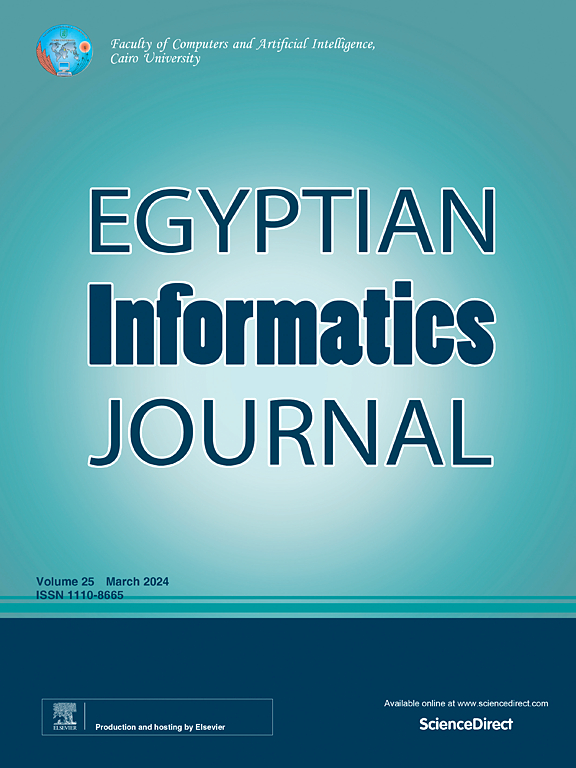Hybrid signal algorithm detection in NOMA 5G waveform: Transforming smart healthcare connectivity by reducing latency
IF 4.3
3区 计算机科学
Q1 COMPUTER SCIENCE, ARTIFICIAL INTELLIGENCE
引用次数: 0
Abstract
The detection of hybrid signal algorithms in Non-Orthogonal Multiple Access (NOMA) 5G waveforms is changing the face of smart healthcare. The integration of NOMA allows multiple simultaneous connections in a given system, which significantly enhances spectral efficiency, ensuring unmatched communication between different medical devices and monitoring systems. Interference mitigation is guaranteed by the proper employment of hybrid signal algorithms that improve correct data interpretation, and are important for maintaining robust connectivity among healthcare facilities with heavy demands. These developments have overcome some of the key challenges in the domain of smart healthcare such as real-time data transmission for remote monitoring, telemedicine, and emergency response. Lowering latency and improving signal reliability will support rapid decision making and patient safety in critical situations. In this paper, we propose a hybrid signal detection algorithm that combines a zero-forcing equalizer (ZFE) and minimum mean square error (MMSE) for the NOMA-MIMO structure with Rician and Rayleigh channels, highlighting its role in empowering next-generation healthcare solutions through enhanced connectivity, reliability, and efficiency. For 16 × 16 and 64 × 64 MIMO-NOMA, the Bit error rate (BER) was evaluated and compared for Long Short-Term Memory (LSTM), ZFE, MMSE, and Maximum likelihood (ML) detection, and the proposed ZFE-MMSE algorithms. The simulation results revealed that the projected LSTM obtains a better BER at a low SNR with high complexity. However, ZFE-MMSE effectively detects the signal at a low SNR, outperforming contemporary algorithms at complexity similar to MMSE and ZFE, and can enhance the latency performance for smart health care applications.
NOMA 5G波形中的混合信号算法检测:通过减少延迟改变智能医疗连接
非正交多址(NOMA) 5G波形中混合信号算法的检测正在改变智能医疗的面貌。NOMA的集成允许在给定系统中同时进行多个连接,这大大提高了频谱效率,确保了不同医疗设备和监控系统之间无与伦比的通信。通过适当使用混合信号算法来保证干扰缓解,这种算法可以改善正确的数据解释,并且对于在有大量需求的医疗保健设施之间保持稳健的连接非常重要。这些发展已经克服了智能医疗领域的一些关键挑战,例如用于远程监控、远程医疗和应急响应的实时数据传输。降低延迟和提高信号可靠性将支持紧急情况下的快速决策和患者安全。在本文中,我们提出了一种混合信号检测算法,该算法结合了零强制均衡器(ZFE)和最小均方误差(MMSE),适用于具有专家和瑞利信道的NOMA-MIMO结构,通过增强连接性、可靠性和效率,突出了其在增强下一代医疗保健解决方案中的作用。对于16 × 16和64 × 64 MIMO-NOMA,评估并比较了长短期记忆(LSTM)、ZFE、MMSE和最大似然(ML)检测的误码率(BER),以及提出的ZFE-MMSE算法。仿真结果表明,投影LSTM在低信噪比和高复杂度下具有较好的误码率。然而,ZFE-MMSE可以有效地以低信噪比检测信号,在类似MMSE和ZFE的复杂性方面优于当代算法,并可以增强智能医疗保健应用的延迟性能。
本文章由计算机程序翻译,如有差异,请以英文原文为准。
求助全文
约1分钟内获得全文
求助全文
来源期刊

Egyptian Informatics Journal
Decision Sciences-Management Science and Operations Research
CiteScore
11.10
自引率
1.90%
发文量
59
审稿时长
110 days
期刊介绍:
The Egyptian Informatics Journal is published by the Faculty of Computers and Artificial Intelligence, Cairo University. This Journal provides a forum for the state-of-the-art research and development in the fields of computing, including computer sciences, information technologies, information systems, operations research and decision support. Innovative and not-previously-published work in subjects covered by the Journal is encouraged to be submitted, whether from academic, research or commercial sources.
 求助内容:
求助内容: 应助结果提醒方式:
应助结果提醒方式:


